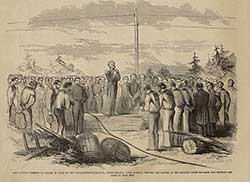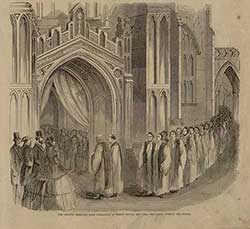
Displaced Representation and Nationalistic
Appropriation: Illustrating the Atlantic
Cable of 1858
- Mark Niemeyer
_______________________________

Fig. 31. Captain Hudson Offering Up Prayer, 1858 

In what could be considered an extension of the theme of peace and harmony that the Atlantic Cable was supposed to foster, illustrations sometimes highlighted a religious view of the project. These examples could also be compared, in certain ways, to those previously discussed that focus on Nature and the idea that the new technology would not disrupt either the preeminence or harmony of the natural world, to the extent that they suggest that this great technological feat achieved by man in no way upset the preeminence or harmony of a God-ruled religious world either. Contemporary articles and poems, in fact, often insisted on the idea that, if this man-made achievement was indeed impressive, the real credit was due to God. One poem, entitled “The Atlantic Telegraph,” which appeared in the Boston Daily Evening Transcript, for example, begins, “Give to God the glory! O’er the Atlantic wave / See the ships returning, beautiful and brave!” [8] Indeed, if advances in science and technology had certainly brought challenges to nineteenth-century religious beliefs, in the year preceding the publication of Charles Darwin’s On the Origin of Species by Means of Natural Selection, a solid religious faith was still held by a large number of people, and others no doubt felt a need to reaffirm that faith or perhaps even to convince themselves and others of its continued truthfulness and solidity in the face of challenges from science and technology. At the same time, as Todd Timmons points out, many Americans in the nineteenth century “embraced progress through science and technology almost as if it were a religion.” [9] The two apparently opposed worlds were, in fact, often closely linked at the time, and, as Timmons also notes, “America’s newfound leadership in technology was understood to be a direct consequence of the country’s superior religious and moral standing.” [10] One illustration, for example, shows William L. Hudson, captain of the Niagara, offering up prayer just after having landed the American end of the cable on the Newfoundland shore (fig. 31). He is surrounded by the officers and crew of the ship, with bowed heads. The bucolic atmosphere of the site is suggested once again by the trees above the level of the men on the left- and right-hand sides of the image, but the most striking, and potentially blasphemous, aspect of the illustration is the single telegraph pole towering above everything—the men, the trees and the central figure of Captain Hudson himself. Already strung with telegraph wires stretching out on both sides of the pole, especially in the context of this scene of prayer and religious reverence, its form is suggestive of a cross and seems to indicate that the very thing the religiously themed illustrations were in part implicitly trying to counteract—the usurpation of traditional religious belief by a veneration of technology—had already become operative. A more purely religious tone is offered in another illustration depicting the Atlantic Cable celebration at Trinity Church, New York (fig. 32), but, it should be noted, the religious dimension is able to dominate this depiction of the robed procession solemnly entering the church at least in part because the cable—indeed technology in any form—is not visually represented.
Nationalistic Appropriation
The examples of displacement strategies in the illustrations of the Atlantic Cable I have discussed so far tend to emphasize the purely technical aspects of telegraphy and the process of the laying of the Atlantic Cable or focus on the positive and more universalist dimensions of the project, highlighting, for example, improved communications, which would supposedly lead to better understanding among nations and greater peace in the world (notably through a strengthened friendship between the United States and Great Britain) or a hope for the spreading of democracy. Others, as just pointed out, underscore a religious dimension of the new link. But another group of illustrations focuses more directly on the human dimension of the Atlantic Cable project, emphasizing aspects such as the heroic drama of the exploit, the great men who helped bring about the success of the undertaking and the extensive celebrations that took place once the news of the completed link reached the public. And many of these illustrations can be seen as having a more or less overtly nationalistic aspect to them, as did many of the celebrations of the event and the articles and poems on the topic [11]. This aspect is in part a direct consequence of the appearance of these illustrations in outlets of the popular press since each nation’s newspapers and magazines (and one can certainly include here the two “instant books” I have examined) tend to help reinforce nationalism regardless of the subject matter. As Ernest Gellner points out, it is the very nature of mass media, “the pervasiveness and importance of abstract, centralized, one to many communication, which itself automatically engenders the core idea of nationalism, quite irrespective of what in particular is being put into the specific messages.” [12] Indeed, in the case of cultural nationalism as it is strengthened by the popular press, to a certain extent, the medium is the message. But beyond this intrinsically nationalistic aspect, the illustrations of the Atlantic Cable project often suggest more or less explicitly that credit for the success of the endeavor belonged primarily, if not exclusively, to the United States of America. And while expressing national pride in relation to such an exploit may seem relatively natural, it was actually somewhat ironic, to say the least, since if the main promoter of the project was indeed the American Cyrus W. Field, there were many good reasons for seeing the Atlantic Cable as more of a British, rather than American, undertaking. For example, the British government offered assistance for the project before the hesitant American government finally agreed to participate; the British people subscribed to a greater amount of Atlantic Cable stock than Americans did; the cable itself was manufactured in England; one of the two ships laying the cable was British, and a majority of the ships in the so-called “telegraph squadron” were British; and, finally, both ends of the main transatlantic stretch of the cable were linked to telegraph stations on British territory (Valentia Bay, Ireland, on the one end and Trinity Bay, Newfoundland, on the other).
[8] “The Atlantic Telegraph,” Boston Daily Evening Transcript (20 August 1858), p. 4.
[9] Todd Timmons, Science and Technology in Nineteenth-Century America, Westport, Connecticut: Greenwood, 2005, p. 5.
[10] Ibid., p. 5.
[11] For a description and analysis of the nationalistic aspect of the cable celebrations and cable poetry, see my article: “Creating a National Heritage, Denying a National Crisis: The Atlantic Cable Celebrations and Atlantic Cable Poetry,” Ceremonies and Spectacles: Performing American Culture, eds. Teresa Alves, Teresa Cid and Heinz Ickstadt, Amsterdam: VU U P, 2000, pp. 152-160.
[12] Ernest Gellner, Nations and Nationalism, Oxford: Blackwell, 1983, p. 127.


